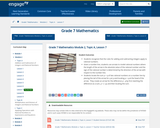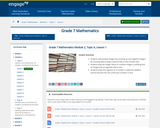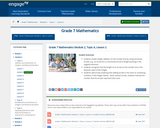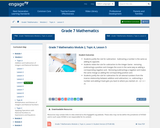
This parent guide supports parents in helping their child at home with the 6th grade Math content.
- Subject:
- Mathematics
- Material Type:
- Reference Material
- Author:
- Kelly Rawlston
- Letoria Lewis
- Date Added:
- 01/05/2022

This parent guide supports parents in helping their child at home with the 6th grade Math content.

This resource accompanies our Rethink 6th Grade Math course. It includes ideas for use, ways to support exceptional children, ways to extend learning, digital resources and tools, tips for supporting English Language Learners and students with visual and hearing impairments. There are also ideas for offline learning.

In this lesson, students recognize that the rules for adding and subtracting integers apply to rational numbers. Given a number line, students use arrows to model rational numbers where the length of the arrow is the absolute value of the rational number and the sign of the rational number is determined by the direction of the arrow with respect to the number line. Students locate the sum p + q of two rational numbers on a number line by placing the tail of the arrow for q at p and locating p + q at the head of the arrow. They create an arrow for the difference p - q by first rewriting the difference as a sum, p + (- q), and then locating the sum.

This simulation allows you to use a slider to see how positive and negative integers add on a number line.

In this lesson, students add positive integers by counting up and negative integers by counting down (using curved arrows on the number line). Students play the Integer Game to combine integers, justifying that an integer plus its opposite add to zero. Students know the opposite of a number is called the additive inverse because the sum of the two numbers is zero.

In this lesson, students model integer addition on the number line by using horizontal arrows; e.g., an arrow for is a horizontal arrow of length pointing in the negative direction. Students recognize that the length of an arrow on the number line is the absolute value of the integer. Students add arrows (realizing that adding arrows is the same as combining numbers in the Integer Game). Given several arrows, students indicate the number that the arrows represent (the sum).

In this lesson, students justify the rule for subtraction: Subtracting a number is the same as adding its opposite. Students relate the rule for subtraction to the Integer Game: removing (subtracting) a positive card changes the score in the same way as adding a corresponding negative card. Removing (subtracting) a negative card makes the same change as adding the corresponding positive card. Students justify the rule for subtraction for all rational numbers from the inverse relationship between addition and subtraction; i.e., subtracting a number and adding it back gets you back to where you started: (m - n) + n = m.

For this interactive, students find the value of each variable.

This course was created by the Rethink Education Content Development Team in partnership with the North Carolina Virtual Public Schools. This course is aligned to the NC Standards for 6th Grade Math.

This course was created by the Rethink Education Content Development Team in partnership with the North Carolina Virtual Public Schools. This course is aligned to the NC Standards for 6th Grade Math.

This course was created by the Rethink Education Content Development Team in partnership with the North Carolina Virtual Public Schools. This course is aligned to the NC Standards for 6th Grade Math.

Lesson Plan using a Cyberchase activity that provides students with practice in accumulating positive and negative point totals in the context of a competition. The activity is motivated by the For Real segment of a Cyberchase episode that emphasizes positive and negative numbers.